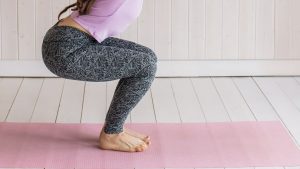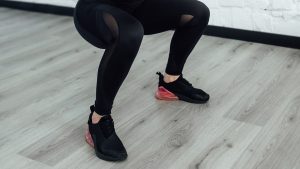Doing Prisoner Squats Without Shoes:
Improved Mobility: Going barefoot can enhance your ankle mobility. It allows your feet to move naturally, engaging more muscles in the process. This can be beneficial for beginners who are trying to develop proper squatting form.

Better Balance and Stability: Being barefoot increases the contact between your feet and the ground, which can enhance your balance. This might help beginners in stabilizing themselves during the squat movement.
Body Awareness: Being shoeless may help you become more aware of your body’s positioning and how your feet are engaging with the ground. For beginners, this awareness can be crucial for mastering the correct form.
Doing Prisoner Squats With Shoes:
Support and Protection: Wearing shoes provides support and cushioning, which can be comforting, especially for beginners who might feel discomfort or pressure on their feet while squatting without shoes.

Grip and Traction: Some shoes offer better grip and traction, preventing slipping during the squatting movement. This can be particularly useful for beginners who are still working on their balance.
Comfort and Confidence: Shoes can offer a sense of comfort and confidence, especially to those who are just starting their fitness journey. For beginners, this comfort might be crucial for building confidence in performing the exercises.
Which Should Beginners Choose?
For beginners, it might be beneficial to start without shoes to develop a better sense of body awareness, balance, and mobility. Gradually, as you become more comfortable with the movement and your form improves, experimenting with shoes or minimalist footwear can provide support and protection without compromising on the benefits of barefoot training.
Ultimately, the choice between wearing shoes or going barefoot during prisoner squats is subjective. Listen to your body, prioritize comfort, and focus on maintaining proper form throughout the exercise.
Let’s dive further into the considerations for doing prisoner squats with or without shoes, especially for beginners.
Tips for Beginners Doing Prisoner Squats:
Focus on Form: Whether barefoot or in shoes, prioritize maintaining proper form throughout the squat. Keep your back straight, chest up, and knees aligned with your toes to avoid unnecessary strain on your joints.
Start Slow and Gradual: Begin with bodyweight squats to familiarize yourself with the movement. As you gain confidence and strength, you can gradually add resistance, such as holding weights, to challenge yourself.
Pay Attention to Comfort: If you’re trying squats without shoes, ensure you’re on a supportive surface. Avoid rough or uneven ground that could cause discomfort or potential injury.
Experiment and Listen to Your Body: Don’t hesitate to try both options—barefoot and with shoes—to see what feels best for you. Pay attention to how your body responds to each variation and choose what feels most comfortable and effective for your workout.
Benefits of Prisoner Squats:
Strengthens Lower Body: Prisoner squats primarily target the quadriceps, hamstrings, and glutes, aiding in lower body strength and muscle development.
Improves Functional Movement: This exercise mimics movements used in everyday activities, making it beneficial for improving functional fitness and mobility.
Requires No Equipment: It’s a convenient exercise that requires minimal space and no equipment, making it accessible for beginners looking to start a fitness routine at home.
External Resources:
The Pros and Cons of Squatting With and Without Shoes – Verywell Fit
The Benefits of Training Barefoot – SELF
Shoes vs. Barefoot for Squats and Deadlifts – BarBend
Conclusion:
For beginners, the choice between doing prisoner squats with or without shoes can influence comfort, stability, and body awareness. Starting barefoot might assist in form correction and muscle engagement, while shoes could provide comfort and support.
Ultimately, the decision should revolve around your comfort, safety, and the ability to maintain proper form throughout the exercise. Experimentation is key try both methods and choose what feels best for your body as you progress in your fitness journey.
Prisoner squats, regardless of footwear choice, can be an excellent addition to a beginner’s workout routine, promoting lower body strength and functional movement.
Comparison tabular on this
Here’s a comparison table summarizing the key points between doing prisoner squats with and without shoes for beginners:
| Aspect | Prisoner Squats Without Shoes | Prisoner Squats With Shoes |
|---|---|---|
| Mobility | Improved ankle mobility, natural foot movement | Provides support, potential restriction in mobility |
| Balance and Stability | Enhanced balance due to increased foot contact | Offers stability and grip for better balance |
| Body Awareness | Heightened awareness of body positioning | Potential comfort and confidence boost |
| Support and Protection | Lack of support but encourages muscle engagement | Provides support and cushioning for comfort |
| Grip and Traction | May vary based on surface | Offers consistent grip and traction |
| Comfort and Confidence | May take time to adjust, promotes awareness | Immediate comfort and potential confidence boost |
Considerations for Beginners:
Form and Awareness: Barefoot squats can enhance body awareness, while shoes provide immediate comfort.
Support and Stability: Shoes offer support and stability, while going barefoot can improve balance and mobility.
Gradual Progression: Start barefoot to learn form, then gradually introduce shoes for added support as needed.
Ultimately, the decision between doing prisoner squats with or without shoes hinges on personal preference, comfort, and the aim to maintain proper form throughout the exercise routine. Experimentation is key to finding what works best for individual needs and fitness goals.
Wrapping up
When it comes to deciding whether to do prisoner squats with or without shoes as a beginner, remember that both approaches offer unique benefits.
Starting without shoes can help improve mobility, enhance body awareness, and strengthen muscles through increased engagement. This approach fosters a deeper understanding of your body’s movements and positions.
On the other hand, using shoes provides immediate comfort, support, and stability. It can be especially beneficial if you’re looking for a sense of security or have concerns about discomfort while squatting barefoot.
Ultimately, the choice should revolve around what feels most comfortable and allows you to maintain proper form. Consider starting without shoes to refine your technique and gradually incorporating shoes for added support as you progress in your fitness journey.
Whether you opt for the freedom of barefoot training or the support of shoes, what matters most is prioritizing your comfort, safety, and the ability to perform the exercise effectively. Experiment, listen to your body, and enjoy your journey toward stronger and healthier workouts!
If you have any more fitness-related queries or want to explore other exercises, feel free to ask!

Hey there, it’s Mike Rrsq, the Editor-in-Chief over at Jsquat.com, and I’m absolutely obsessed with all things squat fitness! I’ve been lucky enough to get some serious recognition for my work in this field. With a solid background in the fitness and wellness industry, I’ve been there right from the get-go, helping shape this website into what it is today.
You see, I’m not just the boss around here; I’m also a passionate contributor. I love sharing my insights through my articles, and trust me, they’re not your run-of-the-mill stuff. Each piece I write is a labor of love, filled with my expertise and real-world experience in the fitness universe. So, if you’re into fitness and looking for some inspiration, you’re in the right place!
Related Posts
- Are Squats Without Weight Effective? (Explained)
Are you wondering if squats without weight are worth your time? Learn the benefits and…
- How to put mass on your legs without barbell squats
Building mass in your legs without relying on barbell squats is definitely possible. While squats…
- Should prisoner squats make me feel a sense of empowerment and self-confidence
Embarking on a fitness journey often extends beyond physical transformation; it can deeply impact one's…
- Can I get stronger legs on bike alone without squats
Strengthening your legs for cycling without relying on squats is feasible. Cycling itself is an…
- Couldn't I Perform the squat exercise without wearing clothes?
Hey there! 🌟 fitness enthusiasts! Ever wondered about the benefits and potential pitfalls of shedding…
- Why Can Squats Be Challenging For Beginners: Explained)
When it comes to building strength, stability, and power in the lower body, squats…
- Are Hack Squats As Good As Squats (Explained)
Are hack squats the real deal or just a pale imitation of the classic squat?…
- Why can't I perform squats without my heels lifting off the ground: Possible Causes and Solutions
Performing squats with your heels staying grounded is essential for maintaining stability and balance. However,…
